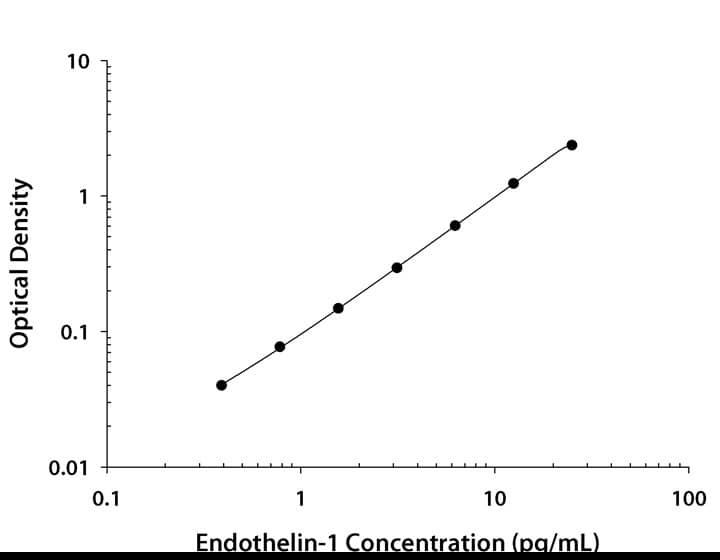Endothelin-1 ELISA Kit - Quantikine Best Seller
R&D Systems, part of Bio-Techne | Catalog # DET100

Key Product Details
Assay Length
Sample Type & Volume Required Per Well
Sensitivity
Assay Range
Product Summary for Endothelin-1 Quantikine ELISA Kit
Product Specifications
Assay Type
Format
Measurement
Detection Method
Conjugate
Reactivity
Specificity
Cross-reactivity
Interference
Sample Values
| Sample Type | Mean (pg/mL) | Range (pg/mL) | Standard Deviation (pg/mL) |
| Human serum (n=35) | 1.24 | 0.47-2.00 | 0.35 |
| Human heparin plasma (n=35) | 1.17 | 0.58-1.96 | 0.32 |
| Mouse serum (n=14) | 3.10 | 1.95-4.03 | 0.58 |
| Mouse EDTA plasma (n=15) | 2.82 | 1.96-3.68 | 0.45 |
| Rat serum (n=15) | 1.63 | 1.32-2.07 | 0.20 |
| Rat EDTA (n=15) | 1.59 | 0.53-2.36 | 0.44 |
| Sample Type | Mean of Detectable (pg/mL) | % Detectable | Range (pg/mL) |
| Human EDTA plasma (n=35) | 1.17 | 97 | ND-1.92 |
| Human urine (n=25) | 0.724 | 48 | 0.44 |
| Condition | Day 1 (pg/mL) | Day 6 (pg/mL) |
| Unstimulated | ND | 1.29 |
| Stimulated | 3.46 | 7.33 |
| Sample Type | Observed Levels (pg/mL) |
| Mouse liver (3 days) | 1.05 |
| Mouse lung (1 day) | 5.15 |
| Rat lung (1 Day) | 20.8 |
Precision
Intra-Assay Precision (Precision within an assay) Three samples of known concentration were tested on one plate to assess intra-assay precision.
Inter-Assay Precision (Precision between assays) Three samples of known concentration were tested in separate assays to assess inter-assay precision.
Cell Culture Supernates, EDTA Plasma, Heparin Plasma, Serum, Urine
| Intra-Assay Precision | Inter-Assay Precision | |||||
|---|---|---|---|---|---|---|
| Sample | 1 | 2 | 3 | 1 | 2 | 3 |
| n | 20 | 20 | 20 | 40 | 40 | 40 |
| Mean (pg/mL) | 3.00 | 7.34 | 14.7 | 3.05 | 7.43 | 14.4 |
| Standard Deviation | 0.120 | 0.170 | 0.280 | 0.231 | 0.438 | 0.759 |
| CV% | 4.0 | 2.3 | 1.9 | 7.6 | 5.9 | 5.3 |
Recovery for Endothelin-1 Quantikine ELISA Kit
The recovery of Endothelin-1 spiked to levels throughout the range of the assay in various matrices was evaluated.
| Sample Type | Average % Recovery | Range % |
|---|---|---|
| Cell Culture Media (n=4) | 99 | 88-108 |
| Human EDTA Plasma (n=4) | 93 | 87-102 |
| Human Heparin Plasma (n=4) | 93 | 85-106 |
| Human Serum (n=4) | 98 | 86-107 |
| Mouse EDTA Plasma (n=4) | 99 | 102-107 |
| Mouse Serum (n=4) | 94 | 86-104 |
| Rat EDTA Plasma (n=4) | 99 | 86-113 |
| Rat Serum (n=4) | 98 | 88-113 |
| Urine (n=4) | 91 | 85-109 |
Linearity
To assess the linearity of the assay, samples spiked with high concentrations of Endothelin-1 were serially diluted with Calibrator Diluent to produce samples with values within the dynamic range of the assay.

Scientific Data Images for Endothelin-1 Quantikine ELISA Kit
Multi-species Endothelin-1 ELISA Standard Curve
Preparation and Storage
Shipping
Stability & Storage
Background: Endothelin-1
Alternate Names
Gene Symbol
Additional Endothelin-1 Products
Product Documents for Endothelin-1 Quantikine ELISA Kit
Product Specific Notices for Endothelin-1 Quantikine ELISA Kit
For research use only
⚠ WARNING: This product can expose you to chemicals including N,N-Dimethylforamide, which is known to the State of California to cause cancer. For more information, go to www.P65Warnings.ca.gov.
